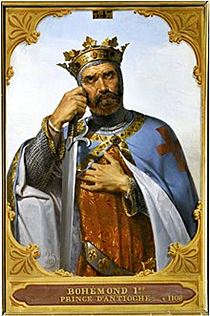
Battle of Larissa(Battle of Pineios) |
year: 1083October 1083 |
| The Normans were defeated and after a while left Greece | ★ ★ ★ ★ ★ |
|
enemy: Normans
|
location: The battle started in Larissa (in Thessaly) and ended by the river Pineios at the passage south of Domenico village
|
accuracy:
●●●●●
|
|
battle type: Surprise Attack |
war: Byzantine-Norman War |
modern country:
Greece |
| ▼ The Byzantines(emperor: Alexios I Komnenos) | ▼ The Enemies | |
| Commander: | Emperor Alexios I Komnenos | Bohemond (son of Guiscard) |
| Forces: | 20,000 | Unknown |
| Losses: |
| Background story: |
| After the capture of Dyrrhachium (1082), the Normans proceeded to take most of northern Greece without facing much resistance. While Robert Guiscard was in Kastoria, he was informed that regions in South Italy were in revolt. He also learned that the Holy Roman Emperor, Henry IV, was at the gates of Rome and besieging Pope Gregory VII, a Norman ally. The byzantine Emperor Alexios I had negotiated with Henry and given him 360,000 gold pieces in return for an alliance. Henry responded by invading Italy and attacking the Pope. Guiscard rushed to Italy, leaving his son Bohemond in command of the army in Greece. Alexios, desperate for money, ordered the confiscation of all the church's treasure and was able to mustered an army near Thessalonica. Bohemond defeated Alexios in two battles: one near Arta and the other near Ioannina (or Dyrrhachium, again). This left Bohemond in control of Macedonia and nearly all of Thessaly. After these victories, Bohemond advanced with his army against the city of Larissa. For two reasons: 1) Larissa was a rich city in the middle of the plains of Thessaly, and Bohemond was hoping to find the funds to pay his army; 2) After spending the winter, in the previous years, in the harsh climate of the upper Western Macedonia, Bohemond was seeking a milder winter climate for his demotivated army. The Normans laid siege on 3 November 1082 (or, according to other sources on 23 April 1083). The commander of the guard of the city Leon Kefalas was able to hold for several months and sent messages to Constantinople asking for help. |
The Battle: |
 Bohemund The Normans chased them for a long distance allowing Alexios with an elite group to attack and ravage their camp. At the same time another part of his army ambushed the rear flank of the Norman cavalry and killed most of their horses. Bohemund reached Tempi with no enemy in sight and considered himself a winner over the Byzantines, for one more time. Then he was informed about the Byzantine attacks and his losses. The main Byzantine army had moved north of Larissa at the fortress of Domenikon and the Normans moved against this position. But before reaching there, they were attacked at a passage of river Pineios and suffered a heavy defeat. It was the first serious defeat of Bohemond in Greece. |
Noteworthy: |
| Alexios granted the Venetians a commercial basis in Constantinople and an exemption from trading duties, in return for their aid. This looked like a good idea at the time, but it was a fatal error that contributed to the decline and fall of the Empire. |
Aftermath: |
| After this defeat, the Normans lost all their gains in Greece and after the death of Guiscard in 1085, they left Byzantine territory. In the meantime, the Venetians recaptured Corfu and Dyrrhachium for Byzantium. |
|
|
